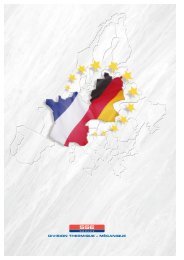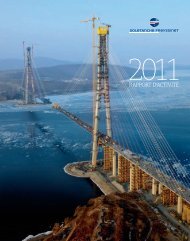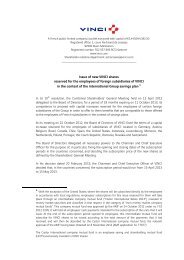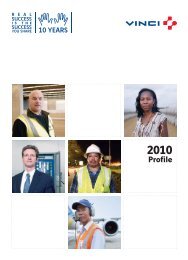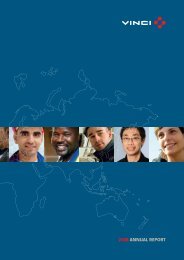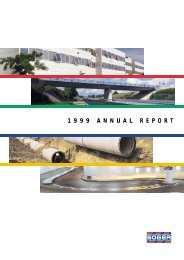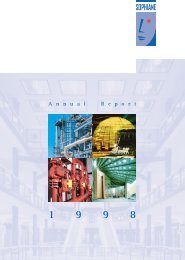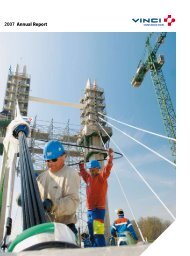VINCI - 2005 annual report
VINCI - 2005 annual report
VINCI - 2005 annual report
You also want an ePaper? Increase the reach of your titles
YUMPU automatically turns print PDFs into web optimized ePapers that Google loves.
Optimising waste<br />
management<br />
<strong>VINCI</strong> continued to introduce waste sorting<br />
across all its businesses in <strong>2005</strong>. In view of<br />
the volume of waste involved, <strong>VINCI</strong><br />
companies are developing ways to reduce the<br />
production of waste at source and optimise<br />
waste sorting, traceability, treatment and<br />
recycling. Waste produced by construction<br />
sites falls into three categories defi ned by<br />
regulations: inert waste, non-hazardous<br />
waste and hazardous waste.<br />
In <strong>2005</strong>, the Paris region purchasing club<br />
initiated a pilot project in which several<br />
<strong>VINCI</strong> companies – Sogea Construction,<br />
GTM Construction, Freyssinet, Eurovia and<br />
<strong>VINCI</strong> Energies – are participating. It involves<br />
setting up a joint system for the global<br />
management of waste from their construction<br />
sites. The volume of such waste reaches<br />
80,000 tonnes a year, of which 60% is inert<br />
waste that can be recycled by Eurovia. The<br />
deployment of a joint programme with<br />
common tools (on-site pre-sorting<br />
equipment, manuals to harmonise treatment<br />
processes, framework contracts with<br />
suppliers, etc.) is to reduce the costs of<br />
managing waste, as well as improve traceability<br />
and the recycling rate. This initiative, which<br />
received the Special Synergies category award<br />
in the <strong>VINCI</strong> <strong>2005</strong> Innovation Awards<br />
Competition, will be audited, formalised and<br />
rolled out to other regions.<br />
Preventing and<br />
limiting pollution<br />
<strong>VINCI</strong> combats noise on two fronts:<br />
innovation (quieter road surfacings and<br />
noise barriers, for example) and the<br />
reduction of noise emissions at their source.<br />
On construction sites, in addition to<br />
complying strictly with noise emission<br />
regulations (especially those applying to<br />
compressors, jack hammers and tower<br />
cranes), the Group’s companies consult with<br />
nearby residents to defi ne working hours<br />
that will reduce their exposure to noise.<br />
Appropriate solutions are implemented on<br />
A RESPONSIBLE GROUP / ENVIRONMENTAL RESPONSIBILITY<br />
Group worksites to protect air quality.<br />
These include the use of sprinklers to limit<br />
dust dispersion when vehicles pass, and the<br />
installation of dust removers directly above<br />
stone crushers in tunnels. Flue gas treatment<br />
techniques are developed by <strong>VINCI</strong> Environnement<br />
for household waste incineration plants,<br />
and by Eurovia for the emissions from<br />
its own industrial facilities. In <strong>2005</strong>, Eurovia<br />
developed a process to reduce volatile<br />
organic compounds (VOC) emitted during<br />
the production of asphalt mixes.<br />
The organisation of 15-minute “environment”<br />
sessions on Group construction sites<br />
raised employee awareness of solutions that<br />
prevent accidental discharges into water and<br />
soil. Settling tanks, fi lters and emergency<br />
spillage kits made up of absorbent materials<br />
are coming into widespread use to prevent<br />
soil pollution and water contamination.<br />
Protecting<br />
the environment<br />
For their design and build projects, <strong>VINCI</strong><br />
companies carry out environmental impact<br />
studies that include a section on fl ora and<br />
fauna, especially for activities related to ICPE<br />
(installations classifi ed for environmental<br />
protection).<br />
PRESERVING THE BALANCE<br />
OF ECO-SYSTEMS<br />
Controlling environmental impacts is a<br />
major concern at every stage of a motorway<br />
project (design, construction and management),<br />
starting with the impact study that<br />
has to be carried out before the project can<br />
be declared of public interest. Once put into<br />
service, motorway infrastructure is subject to<br />
environmental assessment: an intermediate<br />
assessment after one year, and a fi nal assessment<br />
at the end of three to fi ve years.<br />
In May <strong>2005</strong>, Cofi route presented the intermediate<br />
assessment for the A85 motorway.<br />
This checked aspects such as the quality<br />
of the motorway’s fi t with its surrounding<br />
landscape (embankments blending with the<br />
natural contours of the terrain), attention<br />
paid to water treatment (both surface and<br />
ground water), and the protection of wild<br />
animals: the construction of crossings for<br />
both large and small animals, installation of<br />
ponds for frogs, and measures to limit bird<br />
deaths at selected areas of the motorway. In<br />
addition, in January 2006, Cofi route and the<br />
French foundation for the protection of the<br />
habitat of wildlife signed a partnership agreement<br />
for the preservation of biodiversity.<br />
REHABILITATING END-OF-<br />
OPERATION QUARRIES<br />
Group companies transform end-ofoperation<br />
alluvial quarries into leisure centres<br />
for water activities; rock quarries are restored<br />
and reforested. Local liaison and consultation<br />
committees set up by the operating<br />
companies, which local nature protection<br />
associations are invited to join, are essential<br />
for the success of rehabilitation projects. In<br />
<strong>2005</strong>, Carrières Bretagne Sud (Eurovia) won<br />
the best environmental practices award at the<br />
sustainable development competition<br />
organised by the French national union of<br />
aggregate producers (UNPG) for its<br />
restoration of the Quinipily quarry in the<br />
Morbihan region. The quarry, which had<br />
been in operation for almost a century, was<br />
converted back into a natural site. Completely<br />
replanted, it now has a lake where the<br />
excavations took place.<br />
Risk prevention<br />
ECONOMIC RISKS<br />
Only two of <strong>VINCI</strong>’s installations are affected<br />
by France’s national plan for the allocation of<br />
greenhouse gas quotas: Opteor-Sonnex at<br />
Lisieux in Normandy and the CICF factory at<br />
Chateauneuf les Martigues in the south.<br />
Their quotas are 14,429 tonnes<br />
and 159,172 tonnes of CO 2 respectively.<br />
<strong>VINCI</strong> does, however, participate in discussion<br />
groups on the changes that are likely to<br />
occur, particularly on the themes of<br />
“buildings and CO 2 ” and “transport and CO 2 ”.<br />
INDUSTRIAL AND ENVIRON-<br />
MENTAL RISKS<br />
<strong>VINCI</strong> has low exposure to industrial and<br />
environmental risks. Some of Eurovia’s<br />
business activities – binder plants, coating<br />
plants and quarries – are closely regulated<br />
and have characteristics that are similar to<br />
those of industry. They can therefore be<br />
exposed to limited but well identifi ed risks.<br />
The risks presented by binder and coating<br />
plants stem from the fact that they use or<br />
make products that are potentially dangerous<br />
139




